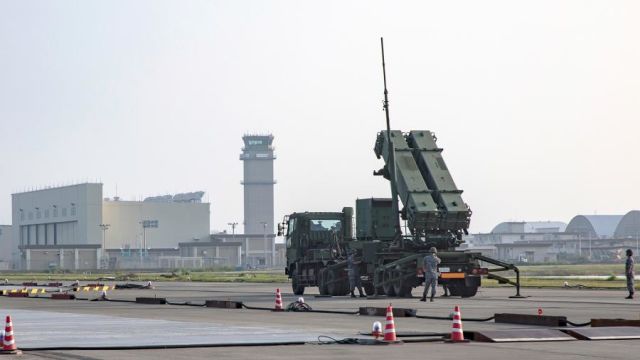Military review of "Izvestia" Anton Lavrov — about the possible transfer to Ukraine of the most powerful air defense system in the American arsenal of the Patriot air defense systemThere is little doubt that the United States will soon decide to transfer the first battalions of long-range air defense systems MIM-104 Patriot to Ukraine.
The United States simply has no other ways to ensure the air defense of its ally in the long term.
The Soviet long- and medium-range S-300 and Buk-M1 complexes that were in service with the VFU are not only on the verge of running out of ammunition. They also bear heavy combat losses from the impact of Russian anti-radar missiles and attack drones.
Washington understands that if the sky over Ukraine is given to the Russian Aerospace Forces, the entire enemy defense system will be doomed. Not only important rear facilities will be hit by aviation, but also artillery and other priority targets in the near rear. That is why the United States will have to take steps that seemed unthinkable before.
Modern air defense systems, which are transferred to Ukraine by European NATO members, are few and do not have the necessary range to cover not only the front line, but also the main nodes of the rear infrastructure. Outdated Hawk air defense systems are a bad argument in modern conditions. Without several Patriot batteries, it is hardly possible to talk about the possibility of protecting at least one Kiev urban agglomeration from cruise missiles.
It is not yet known which of the variants of the American air defense system/The missile defense system will be transferred to Kiev. Older modifications with PAC-2 missiles are focused mainly on defeating drones, airplanes and helicopters. The more modern and expensive PAC-3 is designed primarily for the destruction of ballistic missiles, but can also use conventional PAC-2.
Ukraine is particularly interested in the modern version. It is no coincidence that on December 12, the speaker of the Ukrainian Air Force, Yuriy Ignat, complained in an interview with the German media that they did not have any means to combat Russian ballistic missiles, such as the Iskander. Kiev has not hidden its desire to get the PAC-3 before. It is impossible to exclude that they will achieve their goal.
The sale or temporary transfer of battalions of modern Patriot modifications is a typical step for the United States to help its closest allies. Their battalions are provided to South Korea and Japan, Israel and Saudi Arabia. Since 2014, the creation of an air defense belt along the borders with Russia and Belarus has intensified. These complexes were received not only by Poland, but also by Romania. They dream of their placement in the Baltic states as well.
Israel has repeatedly used Patriot in practice to defeat aircraft and drones. But, perhaps, most of all in recent years, the "Patriots" had to fight in Saudi Arabia. Yemeni Houthi rebels have repeatedly shelled the kingdom's military and oil facilities with low-tech, but long-range cruise missiles and kamikaze drones. It was not always possible to repel such attacks. Suffice it to recall the shutdown of the Aramco plant in September 2019 after a drone raid, which blocked five percent of the world's oil supplies. In the conditions of modern military operations on the territory of Ukraine, American air defense systems will have even more difficult.
The basic tactical unit of the MIM-104 Patriot is a battalion. In addition to the central command post, each of them includes four to six batteries of six launchers for four missiles each. In addition, each battery has its own radar for detecting and highlighting targets, a mobile power plant and a variety of auxiliary equipment. In such a cumbersome structure is the weakness of the American system. It takes up to an hour to deploy it. This is much inferior to the performance of not only Russian mobile air defenses, such as the S-300 and S-400, but also the most modern Western ones.
On the territory of Ukraine, air defense will not operate in the "hothouse" conditions of the Middle East. For the first time, the Patriots will have to constantly maneuver and work at a time when the enemy will hunt them using all means: from anti-radar missiles to hypersonic weapons. The survival rate of their batteries may be lower than that of the old S-300.
Another problem for Kiev is the timing of the development of a complex complex. It will take a long time from the announcement of the transfer plans to the actual appearance in Ukraine. Unlike a simple M777 howitzer, a full training cycle for the Patriots takes many months. This is especially true for the training of officers and their comprehension of tactical techniques. It is no coincidence that many states have to rely for years on "borrowed" battalions from the US Armed Forces with fully American personnel. For obvious reasons, this option is not possible in Ukraine. The arrival of new equipment will have to be stretched over time.
Despite all the shortcomings and difficulties, the transition to Patriots, Hokies and new complexes with AIM-120 missiles will remove the problem of ammunition for their air defense for Kiev. It will no longer be possible to hope for the exhaustion of their reserves in the arsenals. Therefore, our military will have to remember the manuals on the destruction of NATO air defense systems and their radars.
However, it was the opposition to such complexes that whole generations of Soviet and Russian military pilots studied. The armament and equipment of our aviation is also designed primarily to counteract their radars. So the possibilities of such sams for our military will not be a surprise.




